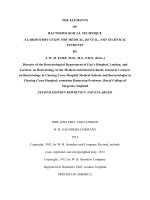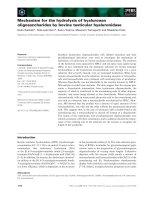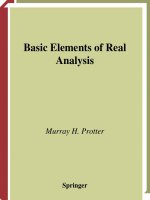The Elements of Blowpipe Analysis, by Frederick Hutton Getman doc
Bạn đang xem bản rút gọn của tài liệu. Xem và tải ngay bản đầy đủ của tài liệu tại đây (489.7 KB, 159 trang )
The Project Gutenberg EBook of The
Elements of Blowpipe Analysis, by
Frederick Hutton Getman
This eBook is for the use of anyone
anywhere at no cost and with
almost no restrictions whatsoever. You may
copy it, give it away or
re-use it under the terms of the Project
Gutenberg License included
with this eBook or online at
www.gutenberg.net
Title: The Elements of Blowpipe Analysis
Author: Frederick Hutton Getman
Release Date: June 25, 2010 [EBook #32974]
Language: English
*** START OF THIS PROJECT GUTENBERG EBOOK
THE ELEMENTS OF BLOWPIPE ANALYSIS ***
Produced by The Online Distributed
Proofreading Team at
. (This file was
produced from images
generously made available by The Internet
Archive/American
Libraries.)
THE ELEMENTS
OF BLOWPIPE
ANALYSIS
THE
ELEMENTS OF
BLOWPIPE
ANALYSIS
BY
FREDERICK
HUTTON GETMAN,
F.C.S.
INSTRUCTOR IN
CHEMISTRY IN THE
STAMFORD HIGH
SCHOOL
New York
THE MACMILLAN COMPANY
LONDON: MACMILLAN & CO., LTD.
1899
All rights reserved
Copyright, 1899,
By THE MACMILLAN COMPANY.
Norwood Press
J. S. Cushing & Co.—Berwick & Smith
Norwood Mass. U.S.A.
PREFACE
These few pages are intended to serve a
twofold purpose,—to give the student a
general outline of Blowpipe Analysis, and
to introduce him to the methods of
Determinative Mineralogy.
Every effort has been made to simplify
details so that the book may be used in
both High Schools and Colleges.
Tables for "systematic" examination have
been intentionally omitted, for in the
author's estimation these tend to dull the
student's power of observation, and to
make him place little value upon minute
details.
The alphabetic arrangement has been
followed for the sake of convenience
when referring to the book.
The last chapter is not intended to serve as
a key to determining the minerals therein
described, but rather it is added to give
the student exercise in Blowpipe
Analysis, and at the same time to point out
the methods of Determinative Mineralogy.
Finally, the author would acknowledge his
indebtedness to the following works:
"Manual of Qualitative Analysis,"
Fresenius; "Qualitative Chemical
Analysis," Venable; Roscoe and
Schorlemmer's "Treatise on Chemistry";
Foye's "Hand-Book of Mineralogy";
Dana's "Mineralogy"; Kobell's "Tafeln zur
Bestimmung der Mineralien"; etc.
Frederick Hutton Getman.
Stamford, Conn.,
Feb. 22, 1899.
TABLE OF
CONTENTS
CHAPTER I
Apparatus and Reagents
CHAPTER II
General Outline of Blowpipe Analysis
Definitions
Examination on Charcoal Alone
Examination on Charcoal with Sodium
Carbonate
Examination in Tube with Sodium
Carbonate and Charcoal
Examination on Platinum Wire
Examination in Borax Bead
Examination with Cobalt Nitrate
CHAPTER III
General Reactions for the Detection of the
Metallic Elements in Simple Compounds
Aluminum
Antimony
Arsenic
Bismuth
Cadmium
Chromium
Cobalt
Copper
Iron
Lead
Manganese
Mercury
Nickel
Silver
Tin
Zinc
The Alkali Metals
Ammonium
Potassium
Sodium
Lithium
The Alkaline Earths
Barium
Calcium
Strontium
The Acid Elements
Borates
Bromides
Chlorides
Fluorides
Iodides
Nitrates
Phosphates
Silicates
Sulphides
CHAPTER IV
Behavior of Some of the Principal Ores
before the Blowpipe
Ores of Antimony
Ores of Arsenic
Ores of Bismuth
Ores of Chromium
Ores of Cobalt
Ores of Copper
Ores of Iron
Ores of Lead
Ores of Manganese
Ores of Mercury
Ores of Nickel
Ores of Silver
Ores of Tin
Ores of Zinc
COMPARATIVE TABLES
I. Colors of Coatings on Charcoal
II. Flame Colorations
III. Colors of Borax Beads in oxidizing
Flame
IV. Colors of Borax Beads in reducing
Flame
V. Colors of Microcosmic Salt Beads in
oxidizing Flame
VI. Colors of Microcosmic Salt Beads in
reducing Flame
ANALYSIS
CHAPTER I
The blowpipe was first applied to mineral
analysis in 1733 by Anton Swab, and its
applications have since been improved
and extended by various chemists, among
whom may be mentioned Bergmann,
Cronstedt, Gahn, Berzelius, and Plattner.
Blowpipe.—The common blowpipe of the
jeweller is not particularly well suited to
the operations of blowpipe analysis, since
the flame has often to be kept playing upon
the assay for some time, and the
condensed moisture of the breath would
seriously interfere with the passage of the
air through the jet. One of the best and
least expensive forms of blowpipe is
shown in Fig. 1. This consists, as is seen
from the illustration, of a conical-shaped
tube of tin closed at the wide end and
formed into a mouthpiece at the small end;
soldered into the tube at the large end, and
at right angles to its axis, is a small brass
tube which terminates in a conical tip
pierced with a very fine hole. With this
pipe it is possible to perform all of the
operations of mineral analysis.
Some little practice is necessary to keep
the flame steady and to take the breath at
the same time.
No rule can well be given to the beginner,
but his experience becomes his best guide.
Bunsen Flame.—Any kind of flame can









